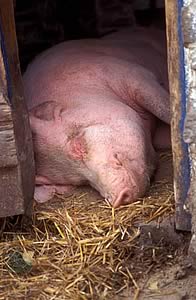17/02/08
With the start of a New Year that pig producers hope to
present fewer unexpected challenges than 2007, reports
from NADIS Veterinary Surgeons attending pig farms are
littered with observations of herds deciding to depopulate
and exit the industry. The availability and possible financial
assistance to control disease associated with Porcine Circovirus
has come too late for some.
Sows
The most concerning observation during the month concerned
the apparent upsurge in disease associated with PRRS
both in breeding and feeding herds. In the former, suspected
disease accounted for episodes of poor quality pigs being
born, abortions and premature farrowings (although in
one case mycotoxins may also have been implicated). It
is 17 years since this disease first appeared in the
UK and as is typical of new diseases, the clinical picture
has changed over time to become less specific and fortunately
less devastating. However, it is still capable of imposing
severe constraints on health and production and it may
be significant that the proportion of all herds recorded
under NADIS that are using PRRS vaccines has dropped
from 31% in 2006 to 23% in 2007. Could it be that cost
saving measures in the form of reduced vaccinations are
allowing disease levels to rise?
Other specific issues
noted in the breeding herd in January included:
- Problems
with sow condition believed to be the result of deterioration
of insulation material in dry sow accommodation and a
shift from using barley straw to wheat. The former can
contribute significant levels of energy and is quite
palatable. Wheat straw, particularly some of the poorer
quality material available this year, has neither benefit.
- Service problems due to poor heat detection particularly
in gilts, associated with staff problems.
- A 24% drop in farrowing rate in a herd that changed
from weekly to 3 weekly batch farrowing in the first
cycle. Semen quality was also questioned.
Piglets
Specific piglet issues were not widely reported in January
although comments regarding piglet quality both at birth
and weaning were received. These were thought to be associated
with disease (PRRS), nutrition and stockmanship.
Meningitis
appeared as a major problem in one herd at 2-3 weeks
where not previously experienced. No explanation of why
was offered.
Weaners
Overstocking continues to be a regular observation and
if successful Circovirus vaccination is to be widely applied
this problem will only get worse. The reasons identified
included excess farrowings, slowed growth, and continued
problems with marketing finishing pigs which has a backing
up effect throughout the farm. Fortunately this problem
seems to now be easing.
Overstocking, and pressure on accommodation
generally, will certainly not help reduce the impact of
many of the specific problems identified in the month,
which included PMWS, (exacerbated by PRRS) tail biting,
ear tip necrosis, Salmonella associated post weaning scour
and ileitis. In addition, greasy pig disease, atrophic
rhinitis (now something of a rarity in the UK) and Swine
Dysentery were all reported.
Inadequate
ventilation control and insulation, and lack of heating
was highlighted as causing chilling which will equally
tend to exacerbate disease.
Grower/Finishers
Many familiar problems were highlighted
in the older feeding herd in January, with overstocking
still a serious issue on some farms, specifically associated
with vice and widespread enteric disease. There appears
to be something of an increase in reports of Swine Dysentery,
especially in East Anglia, and producers will need to be
wary of any increase in grower scours if early detection
is to be achieved.
PMWS was reported
in its late onset form, in one case contributing to losses
of 40%, acting as a reminder of the essential basic husbandry
needs of avoidance of chilling and overcrowding (the latter
often used in winter in an attempt to reduce the former).
Straw based pigs in naturally ventilated buildings are
prone to chilling in winter when inadequate bedding is
made available but producers should also be aware of the
potential problem, highlighted in one report, of Erysipelas
in growing pigs on straw, even in cold weather. (Erysipelas
is erroneously often viewed as a warm weather disease.)
This infection was also possibly implicated in an acute
lameness problem in growers although Haemophilus parasuis
was also thought to be involved.
The
continued mixing of sources of weaners into finishing accommodation
perpetuates respiratory disease reports and until such
practices cease, disease will limit production.
Finally,
two parasitic problems were highlighted:
- Lice – rarely
seen in commercial production, these skin parasites were
seen in a ‘hobby farm’ and
can be implicated in disease spread.
- Milk spot livers – the result of migration of
Ascaris Suum worm larvae – cannot be detected in
the live animal. Membership of BHPS will assist monitoring
this condition, which can have a serious impact on growth.
Through
what are expected to be the coldest months of February
and March, problems should be anticipated with:
- Chilling
triggering scour etc
- Poor air flows exacerbating respiratory disease
- Water supply problems
- Difficulties with frozen ground
outdoors, limiting feed and water uptake and mating behaviour.
Mark White BVSc DPM MRCVS
Copyright © NADIS 2008 www.nadis.org.uk
 NADIS Pig Health Report for December 2007 NADIS Pig Health Report for December 2007
 China
Pig Meat Exports a Step Closer China
Pig Meat Exports a Step Closer
 NADIS Pig Health Report for November 2007 NADIS Pig Health Report for November 2007
|



